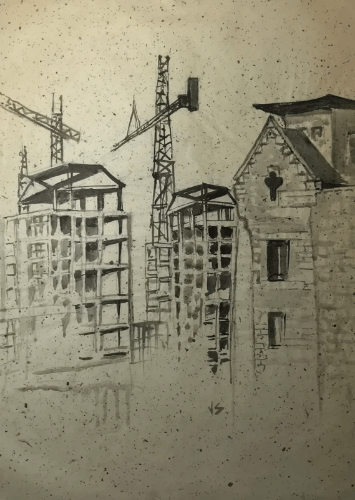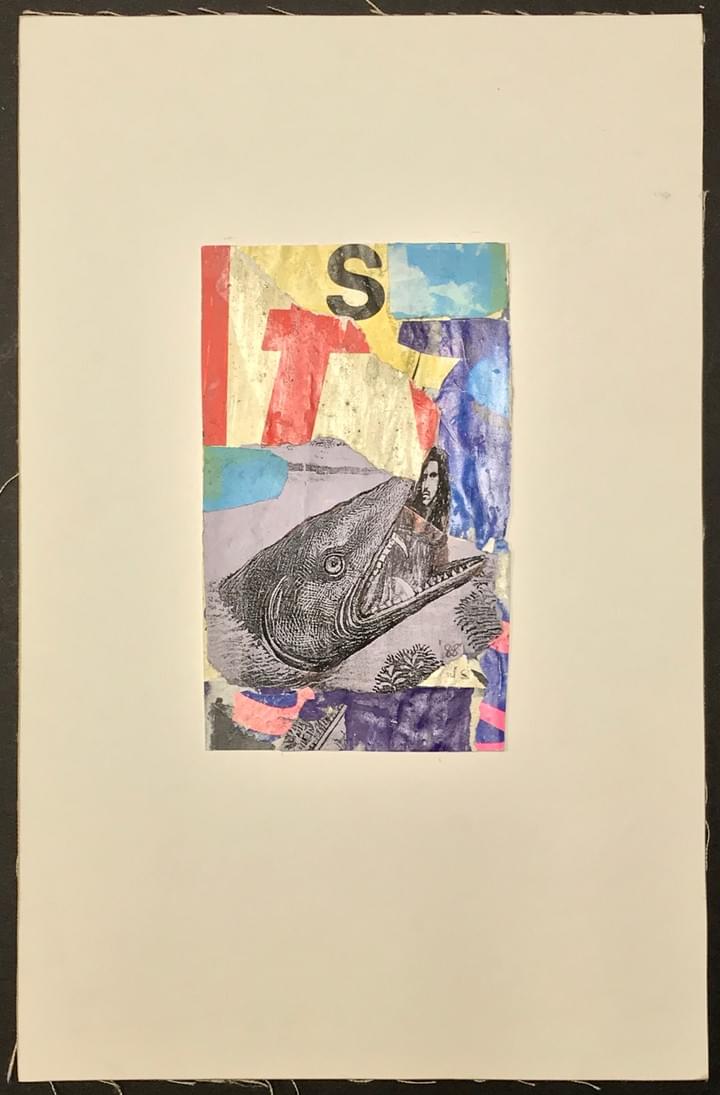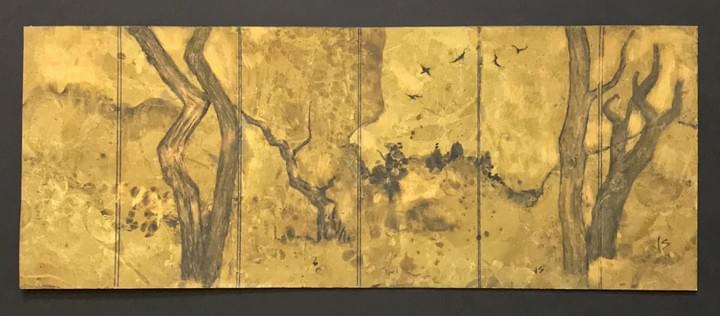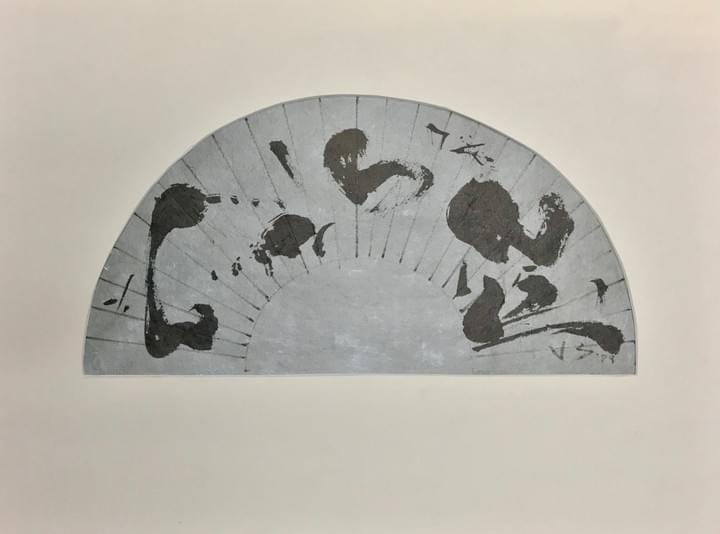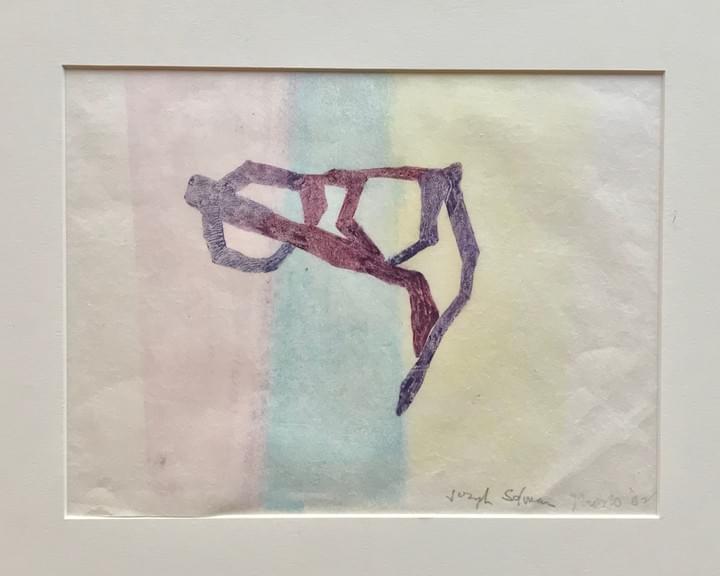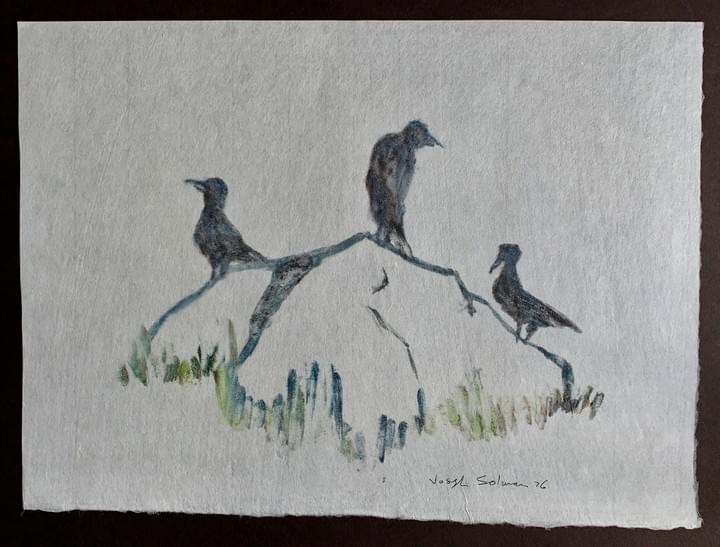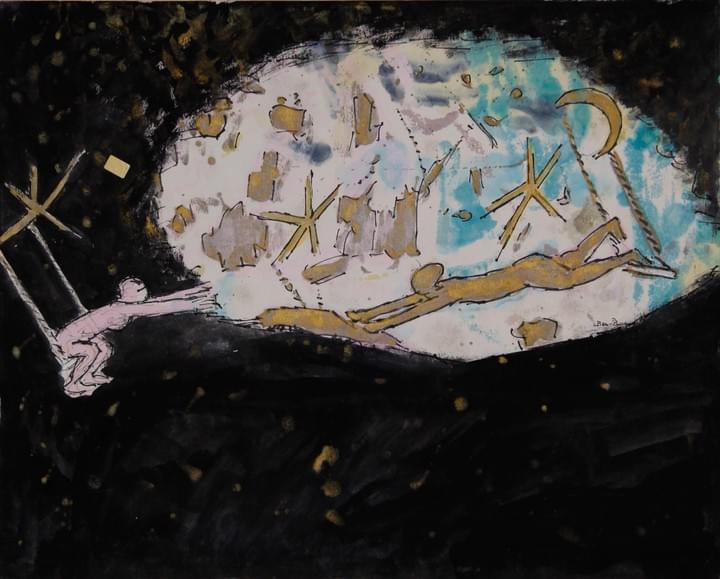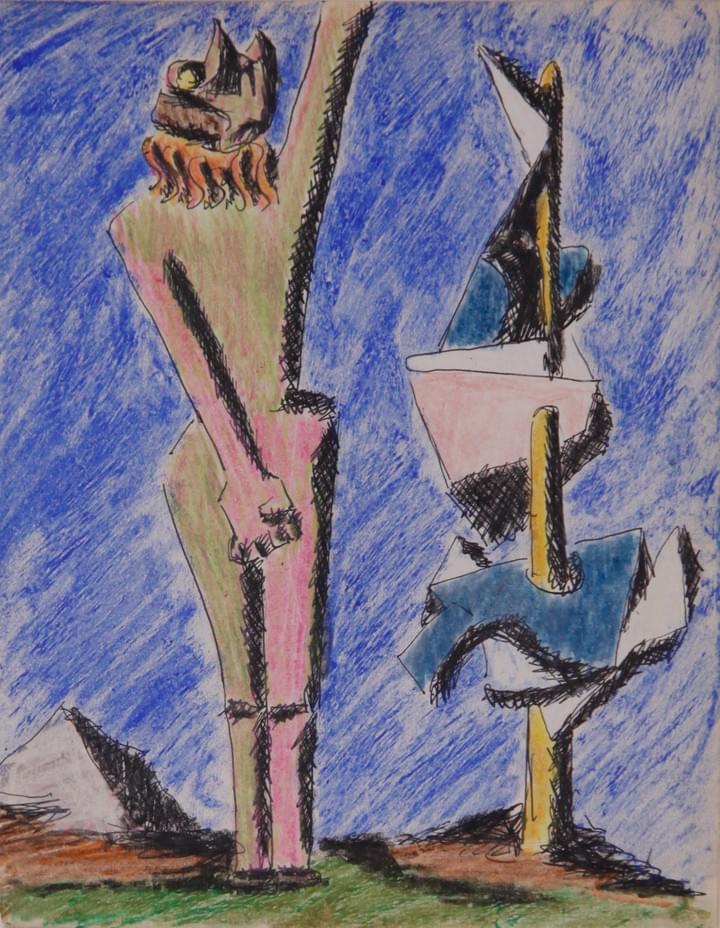
Welcome to the Joseph Solman Virtual Gallery Collection
Browse the collection and take your time.

The Sections
Organized by artist and genre. Click on any of the artists or genres below, to be brought to the section. Or just scroll down and look for yourself. When in your desired section, scroll horizontally.

Sunset, Manhattan
In Joseph Solman's last two decades, he returned to the buildings of New York, but was now focused on exploring the contrast between its buildings and the shapes (and colors) of the sky they framed. This is a facsimile of a favorite monotype, published in a signed and numbered edition.
Monotype facsimile (edition of 100) Ca. 1990 15"x20" $500

Still Life With Pipe
A photolithograph of a painting ca. 1950, printed around the year 2000 when Solman was 90.
Painting facsimile (edition of 50)
15"x17" $400

Venus of 23rd St
In the '90s, Solman created a facsimile of one of his major paintings from the '30s: Venus of 23rd St. (PL. 7, Joseph Solman, Abe Chanin, Crown Publishers, 1966; PL. 39. Joseph Solman, Dore Ashton et al., Da Capo, 1995; )
Painting Facsimile (15"x18") $600

Tar cart with black bucket of tar (beige paper)
Solman did a very few etchings, of which this is one, using a familiar subject that began to intrigue him in the '60s: the tar cart.
Etching Undated (21"x18") $600

Country Road
A NY street in a genre distinctly Solman-esque medium: Magic Marker.
Colored drawing
Undated (10"x8") $900

The Lone Motorcycle
A lone motorcycle, with Solman's typical dash of bright color
Magic Marker drawing
Undated (13 7/8"x10 1/2") $875

Mr. Blue Sky
A different version of the plunging NY "skyline" Solman became nearly obsessed with in his later years
Magic Marker drawing
Undated (13 7/8"x10 1/2") $775

Redwood
Solman's beloved subject: the tree, with its infinite variety of living lines. "A line must always move," he said.
Wash drawing
Undated (13 7/8"x10 1/2") $725

Rush Hour
The Chrysler Building beckons cars in the '60s, pre-Uber
Magic Marker drawing
Undated (13 7/8"x10 1/2") $875

New Kids on the Block
An added background to give this trio of motorcycles even greater dignity.
Colored drawing
1987 (14"x10 1/2") $875

Tug
A boat on the East River, with Brooklyn (or is it Queens?) on the far shore.
Magic Marker
Undated (13 7/8"x10 1/2") $675

Construction in Magic Marker
An unusual city scene, in that he leaves some of the buildings deliberately unfinished for contrast.
Magic Marker and ink
Undated (13 1/2"x17") $1,050

The Garbage Bag
Solman so loved the world, he endowed even the humblest subjects with dignity.
Ink and watercolor Undated (12"x8 3/4") $700
Bike Trio
Solman began depicting the city in the early 1930s. It wasn't until the '60s that he focused on its tar carts and motorcycles.
Ca. 1987 (15 1/2"x8") $3,500

After Chu Ta
Here, Solman copies the 17th century Chinese master Chu-Ta. Though trained in the Western tradition, he put Chu-Ta in his pantheon.
ca. 1987 (18"x12") $4,000

Flock in Flight
An ink drawing in the manner of Japanese sectional design. Solman uses the technique to provide a stage set for his lively protagonists. Undated (24"x18")
$2,500

Descent
A sumi on heavily textured paper. The Zen images (and poetry) considered pinnacles of mastery are often the simplest.
Undated (16 3/4"x12") $3,300

Twisted
A significant example from Solman's tree series. Consider them carefully, and the trees have distinct personalities
Ca. 1988 (24"x18") $4,000

Finally: A Tree With Leaves
Not all of Solman's trees were naked.
Undated (21"x33 1/2") $6,000

Forked
The most Zen-like of sketches, Solman didn't even sign this one-- not an indication of being unfinished, but of stark simplicity.
Undated (17 1/2"x24")$4,250

Snow City
A sumi reminiscent of Kawabata's novel, transposed to New York. Undated (14 1/4"x22") $4,000

Let the Leaves Bleed
Solman rarely used watercolor technique in his ink drawings. Here he does.
Undated (17"x14") $3,800

Empire State as Voyeur
In the late '80s, Solman worked from a studio at 41 Union Sq. West, also artistic home to Hank Virgona, "the Amerian Morandi," whose work is featured below. The Empire State building is about a mile away.
1988 (18"x24") $4,250

Construction in Japanese Ink
Eastern technique on New York's East Side
1987 (27 1/2"x38") $10,000

Construction in Japanese Ink (2)
(Solman's #1 sumi-e, in our estimation)
A more detailed and exquisite rendition of the construction scene sumi.
Ca. 1989 $12,500
(37 1/2"x37 1/2")

Not the Letter I Expected
A funds appeal from the US Committee for the German Democratic Republic. Communist East Germany, that is. No wonder it was unexpected. 1979 (12"x9")
$2,300

The East River in Winter
His collage titles are testament to his playfulness.
1979 (9 1/2"x8")
$1,900

A High Five
Solman often said that life was a game and art, the greatest game of all.
1989 (8"x4 1/2")
$1,750

Don Quixote
Tilting at windmills, of course.
1989 (5 1/4"x7 3/4")
$1,675

Jonah and the Whale
Solman made collages early in his career, in the tradition of Max Ernst, and later.
1988 (4"x6 1/2")
$1,500

Masks and Skyscrapers
Maybe a colossal conversation?
1988 (4"x3 3/4")
$1,200

"If it's broke, don't fix it."
A twist on the cliche. Brokenness can be arresting? Beautiful? Don't mess with the serendipity of collage? 1988 (6 1/2"x6")
$1,300

German Movie Poster
It presumably was just that.
1979 (8"x10")
$2,000

Narcissus
Might be renamed the Narcissus Four or The Narcissi since each member of the boy band is Echoed (undated) (14 3/4"x10 1/4")
$2,400

Radar Loses the Code
The title speaks for itself (or doesn't).
1989 (12 1/4"x8")
$2,200

Split Solo
Solman bisects the bike in the Asian manner.
Ink on paper Undated (12 1/2"x3") Framed: (19 1/4"x8") $800

小さい鳥 (Little Bird)
This is a 1983 monotype -- a print taken from a painting on glass -- inspired by the 17th century Chinese master, Chu Ta. Click on "Behind the Art" (top of page) for the story of his influence on Solman.
SOLD
Monotype 1983 (14 3/4"x11") $1,800

Zen Birds
A sketch from Solman's Good Harbor cottage.
Marker on paper (10 1/2"x14") $1,200

Pure Gold
Gloucester Massachusetts imagined as a Chinese or Japanese screen. The image doesn't bend, but the vertical lines give the impression that the landscape is being seen through a window.
Ink on gold paper 1992 (24 1/4"x9 1/2") $7,500

Pecking Order
Again, the Asian screen technique, a way of distancing viewers while focusing their attention on parts, not just the whole.
Marker on paper Undated (18"x8") $1,500

Branch Party
Each bird with a personality of its own
Marker and paint on gold paper Undated (18 3/4"x5 3/4"; framed (22 1/4"x9 1/4")
$4,000 (framed)

Bullies
Solman's beloved motorcycles (beloved as subjects, not transportation -- he never to our knowledge rode one)
Marker and oil on gold paper Undated (21"x15 3/4") $5,025

China Grove
Ca. 1960, Solman was commissioned to spray-bruch paint the walls of a Greenwich Village Chinese retaurant (the Jade Cockatoo) in the Chinese manner and consulted various scrolls and other landscape images. This is reminiscent of the vistas he air-brushed on the walls.
Ink on gold paper 1997 (21 1/2"x9 1/2") $9,000

A Miniature Screen
Chinese and Japanese screens were divided vertically and much larger than this. Their name in Japanese, Byōbu (屏風), means wall to protect against the wind. Solman's wouldn't protect against the mildest gust of air. But the spirit of the wind is in every frame.
Marker on gold screen (Undated) (26 1/2"x12")
$10,000

金色摩托车(Golden Motorcycles)
Solman loved transposing objects of the West to East Asian design.
Marker and paint on gold paper Undated (24 1/4"x9 1/2") $8,000

The Lineup
Here Solman assembles a group of bottles in the manner of one of his revered masters, Giorgio Morandi, the great influence on Solman's younger friend artist, Hank Virgona.
Ink on gold paper Undated (24"x9 1/2") $7,500

Blossoms on Blue
Solman's fans were intimate, personal. To the best of our knowledge, he never exhibited them. Note the "folds" of the fan.
Monotype on fan-prepared paper (Matted: 20"x16") $1200

Marbleized
Solman was intrigued by all sorts of surfaces: colorful, patterned, different. He once saw a metal tile in the window of a tile store and asked if he could buy it. He was given it as a gift.
Monotype on fan-prepared paper (Matted: 20"x16") $1200

Peacock
Solman experimented throughout his 80+-year career. He began doing monotypes in earnest around age 60; fans, closer to 80.
Monotype on fan-prepared paper (Matted: 20"x16") $1200

Torn
A "figurative" artist, Solman was an early champion of abstraction, elected editor of the artist's union Art Front magazine in the late 1930s for organizing opposition to a cartoon in the magazine by his friend Phil Bard of Don Quixote tilting at an abstract image.
Monotype on fan-prepared paper (Matted: 20"x16") $1300

The Great Wall
1990 was an especially violent year in Solman's beloved New York City as the crack crisis peaked.
Monotype on fan-prepared paper (Matted: 20"x16") $1200

Seashell
A fan, with folds and even scalloped edge. Note: Solman's wife Ruth (our mother and great-grandmother) never used a fan, though her Russian mother very occasionally did.
Monotype on fan-prepared paper (Matted: 20"x16") $1500

Plants behind bars
The bars are folds of the fan, of course, an East Asian technique integrated here into the image itself.
Monotype on fan-prepared paper (Matted: 20"x16") $1200

Not the Story of O
Images transferred from elsewhere, and the artist's imagination.
Monotype on fan-prepared paper (Matted: 20"x16") $1200

Caligrafaux in Grey
East Asian-influenced format; East Asian-influenced calligraphy.
Monotype on fan-prepared paper (Matted: 20"x16") $1300

Overseer
Bird on a skinny, sprawling tree. This fan, like so many, was executed during his East Asian period, starting in the late 1980s.
Monotype on fan-prepared paper (Matted: 20"x16") $1400

Seeing the World in Color
Solman loved the simplicity of eye glasses and especially their frames. This is a monotype from 1982. It's also the basis of the Joseph Solman Virtual Gallery logo.
Monotype 1982 (12"x9") $2,100

Lawn Chairs
A monotype from Solman's signature table-and-lawn-chairs series. Here he used a Q-tip to wipe away paint from the glass surface.
Monotype 1987 (15 1/2"x12") $1,700

Sniffen Court
A New York monotype of the small, famous neo-Romanesque street built in the 1860s. Note the pub horse icon in the middle, harkening back to Solman's preoccupation with New York street signs in his days with The Ten in the 1930s.
Monotype 2000 (16 1/2"x 19") $2,200

Perry
1969 (12"x17 1/4")
Monotype (12"x16"( $1,975

A Story Unfolds
A monotype; a second (and thus fainter) impression. Like so many artists, Solman preferred worn objects to new ones.
Monotype 1980 (14 1/2"x11 3/4") $1,750

Orange Sky
A masking tape stain, long covered by a mat, suggests the importance of this image to Solman, as he prepared it for framing. The emphasis in this monotype is on the drawing. And the sky, of course.
Monotype 1984 (10"x17") $2,200

Specs in black and white
Solman said he never became a pure abstractionist because of the infinite number of shapes, lines and colors in nature. His variations on the theme of spectacles proves the point.
Monotype 1981 (7x11") $2,000

Picking Up After
Everybody does their share. Even those who look like little green army men.
Monotype 1981 (12"x16 3/4") $1,875

"When shall we three meet again?"
Solman's birds sometimes seem to be quick studies in portraiture.
Monotype 1976 (15 1/4"x11 1/8") $1,950

After Picasso
Solman occasionally reprised the work of masters he admired. Not surprisingly, Pablo Picasso was among them
Monotype 1994 (15"x12") $2,200

Leafing Out
This tree, less stark than many of Solman's, seems more about its relationship to its leaves than to its angularity.
Monotype 1991 (12 1/2"x16 1/2") $2,000

Arthropod
Motorcycles were forever parked outside the 6-story apartment building into which Solman moved the family in 1952. On Manhattan's 10th St. and Second Ave. the neighborhood with no name become, by the late '50s, "the East Village." By the Sixties it was hipper than hip, the old double-feature movie theater the Loew's Commodore morphing into the Fillmore East; the Polish National Home, the Dom Discotheque.
Monotype 1979 (13"x12") $1,700

Bridge of Sighs
Next to New York, Venice was Solman's favorite city for sketches, bringing home the best to put under glass and use as template for paintings, of which he would take a single impression -- a monoprint or "monotype." Most of the Venice monotypes have long since sold. This is from the last batch of private family stock.
Monotype 1977 (11 1/4"x8 3/4") $2,200

White Pitcher and Green Apples
Poet Ben-Zion Weinman came to America from Poland before Hitler came to power. Listening to "Der Fuhrer" on the radio, he felt that words had been so corrupted, he took up visual art in their place. An original member of The Ten (with Solman and Rothko), Ben-Zion was much influenced by Max Beckmann. But his imagination defined his work.
Oil on Board 1937 (11 x 9 1/2) $3000

The Awakening of the Subconscious
The titles here are those of Ben-Zion himself, as can be seen in this drawing. The artist was all about the inner self (or selves). His inventivess was inexhaustible.
1949 Ink on paper (6.75 x 5) $1000

Woods
Ben-Zion was fascinated by the outdoors. Some of his greatest work is of wheat fields, one such painting purchased by the famed Washington DC modernist collector Duncan Phillips.
Ink on paper 1960 (9 1/2 x 7 1/4) $1200

Still Life
An unusual example of Ben-Zion's graphic work. His intricate cross-hatching in apparent in the background and shadows, but the objects on the table are more polished, less jagged, reminiscent of Morandi's etchings and later, Hank Virgona's. Like Joseph Solman, all three artists were utterly devoted their idiosyncratic vision, caring not a whit for the trendy conventions of their eras. This was the criterion for inclusion in The Ten, of which Ben-Zion was the Biblically influenced outsider.
Ink on paper 1957 (21 1/2 x 19) $3200

Prophet at Night
An unusual example of Ben-Zion's graphic work. His intricate cross-hatching is apparent in the background and shadows, but the objects on the table are more polished, less jagged, reminiscent of Morandi's etchings and later, Hank Virgona's. Like Joseph Solman, all three artists were utterly devoted to their idiosyncratic visions, caring not a whit for the trendy conventions of their eras. This was the criterion for inclusion in The Ten, of which Ben-Zion was the Biblically influenced outsider.
Ink on paper 1957 (21 1/2 x 19) $3200

Acrobats in the Moonlight
A Ben-Zion unlike any other: a sky fantasy replete with the usual stars and crescent moon, with the night drawn back. to reveal the hi-jinks of daylight behind it. The trapeze artist on the right is performing an act of extreme faith, but perhaps that's the point.
Gouache & Watercolor, (19 x 24) $8000

Desert
One of Ben-Zion's vast-seeming landscapes, of the sort that Duncan Phillips to buy one for his collection. A later work.
Oil on canvas, 1975, Oil on Canvas 1976 (20 x 40) $26,000

Commodity
A commentary on commodity culture. Ben-Zion 's house was a wonder palace to a kid like me (Paul Solman, Joseph's son). He collected sculptures and sculptural scraps from every culture, artifacts, mineral specimens, odd stones. When on occasion I would become entranced with one, he would gift it to me. (I still remember a little ebony elephant with ivory tusks.) I thought of him then as a kind magician, came to see that self in his art.

Abstract Figure
Which is the abstract figure? Presumably the one on our right. But note the hairdo of the figure on the left. Ben-Zion was primarily but not exclusively a "representational" artist. Here he blends real shapes with imagined one
Ink & Crayon, 1943 (8.25 x 6.75) $1500

Dutch Sunset
"Jeff Lion Weinstock is a native New Yorker whose photographs pay homage to the city and what you might call secret spectacles. His "Walls" update Aaron Siskind and the whole great 1950s New York School by scouting fresh materials and sites and tinkering with colors -- a mix of acid and cool -- that gently, almost serenely nudge ready-made abstraction into a fresh century. 'In photography, the smallest thing can be a great subject,' Henri Cartier-Bresson once said, adding that 'the creative instant lasts but a brief moment.' Weinstock seizes it, time and again. -Michael Kimmelman
8 1/2" x 11"—$400 (signed, unlimited edition)
17"x 22"—$750 (signed, edition of 40)
24" x 36"—$1,400 (signed, edition of 20)

Red
Life imitates art yet again. Or did Rothko look closely at walls? A wall on a par with Rothko's early color field experiments.
Small: 8 1/2" x 11"—$400 (signed, unlimited edition)
Medium: 17"x 22"—$750 (signed, edition of 40)
Large: 24" x 36"—$1,400 (signed, edition of 20)

Adolph Gottlieb
Gottlieb was another member of Solman and Rothko's Ten. With Rothko, he "went abstract" in the 1940s. To Weinstock, New York's walls still echo his work.
Small: 8 1/2" x 11"—$400 (signed, unlimited edition)
Medium: 17"x 22"—$750 (signed, edition of 40)
Large: 24" x 36"—$1400 (signed, edition of 20)

Pollack
Jackson Pollack was not a member of The Ten, though he and Solman served together briefly on the "mural project" of the WPA on the eve of WWII. Weinstock was influenced by both.
Small: 8 1/2" x 11"—$400 (signed, unlimited edition)
Medium: 17"x 22"—$750 (signed, edition of 40)
Large: 24" x 36"—$1,400 (signed, edition of 20)

Hungary Countryside
Weinstock's work doesn't just echo The Ten, of course. Each wall fragment is a genre of its own.
Small: 8 1/2" x 11"—$400 (signed, unlimited edition)
Medium: 17"x 22"—$750 (signed, edition of 40)
Large: 24" x 36"—$1,400 (signed, edition of 20)

Wynton: Allegro
Weinstock's photographs are especially striking when printed large. He uses simple white frames -- thin ones.
Small: 8 1/2" x 11"—$400 (signed, unlimited edition)
Medium: 17"x 22"—$750 (signed, edition of 40)
Large: 24" x 36"—$1,400 (signed, edition of 20)

Tangled up in Blue
The images are from the neglected surfaces in the real world, but they conjure up other worlds entirely.
Small: 8 1/2" x 11"—$400 (signed, unlimited edition)
Medium: 17"x 22"—$750 (signed, edition of 40)
Large: 24" x 36"—$1,400 (signed, edition of 20)

Havana Mask
From a wall in Cuba.
Small: 8 1/2" x 11"—$400 (signed, unlimited edition)
Medium: 17"x 22"—$750 (signed, edition of 40)
Large: 24" x 36"—$1,400 (signed, edition of 20)

The eyes have it
New York in tatters.
Small: 8 1/2" x 11"—$400 (signed, unlimited edition)
Medium: 17"x 22"—$750 (signed, edition of 40)
Large: 24" x 36"—$1,400 (signed, edition of 20)

The Saxophonist
This one is particularly striking in Weinstock's largest size. It hung in his living room for years.
Small: 8 1/2" x 11"—$400 (signed, unlimited edition)
Medium: 17"x 22"—$750 (signed, edition of 40)
Large: 24" x 36"—$1,400 (signed, edition of 20)

Mt. Fuji
A 37th view, far from the mountain itself.
Small: 8 1/2" x 11"—$400 (signed, unlimited edition)
Medium: 17"x 22"—$750 (signed, edition of 40)
Large: 24" x 36"—$1,400 (signed, edition of 20)

Orange Sky
Shot in Maspeth, Queens, with the board manipulated
Small: 8 1/2" x 11"—$400 (signed, unlimited edition)
Medium: 17"x 22"—$750 (signed, edition of 40)
Large: 24" x 36"—$1,400 (signed, edition of 20)
© 2019 Joseph Solman Virtual Gallery LLC


























